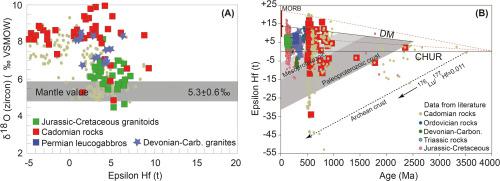当前位置:
X-MOL 学术
›
Gondwana Res.
›
论文详情
Our official English website, www.x-mol.net, welcomes your
feedback! (Note: you will need to create a separate account there.)
Tracking the birth and growth of Cimmeria: Geochronology and origins of intrusive rocks from NW Iran
Gondwana Research ( IF 7.2 ) Pub Date : 2020-11-01 , DOI: 10.1016/j.gr.2020.06.012 Hadi Shafaii Moghadam , Qiu-li Li , William L. Griffin , Orhan Karsli , Jose F. Santos , C.J. Ottley , Ghasem Ghorbani , Suzanne Y. O'Reilly
Gondwana Research ( IF 7.2 ) Pub Date : 2020-11-01 , DOI: 10.1016/j.gr.2020.06.012 Hadi Shafaii Moghadam , Qiu-li Li , William L. Griffin , Orhan Karsli , Jose F. Santos , C.J. Ottley , Ghasem Ghorbani , Suzanne Y. O'Reilly

|
Abstract New geochronological and geochemical data for Late Neoproterozoic to Mesozoic intrusive rocks from NW Iran define major regional magmatic episodes and track the birth and growth of one of the Cimmerian microcontinents: the Persian block. After the final accretion of the Gondwanan terranes, the subduction of the Prototethyan Ocean beneath NW Gondwana during the Late Neoproterozoic was the trigger for high magmatic fluxes and the emplacement of isotopically diverse arc-related intrusions in NW Gondwana. The Late Neoproterozoic rocks of NW Iran belong to this magmatic event which includes intrusions with highly variable eHf(t) values. This magmatism continued until a magmatic lull during the Ordovician, which led to the erosion of the Neoproterozoic arc, and then was followed by a rifting event which controlled the opening of Paleotethys. In addition, it is supposed that a prolonged pulse of rift magmatism in Persia lasted from Devonian-Carboniferous to Early Permian time. These magmatic events are geographically restricted and are mostly recorded from NW Iran, although there is some evidence for these magmatic events in other segments of Iran. The Jurassic rocks of NW Iran are interpreted to be the along-strike equivalents of a Mesozoic magmatic belt (the Sanandaj-Sirjan Zone; SaSZ) toward the NW. Magmatic rocks from the SaSZ show pulsed magmatism, with high-flux events at both ~176–160 Ma and ~130 Ma. The SaSZ magmatic rocks are suggested to be formed along a continental arc but a rift setting is also considered for the formation of the SaSZ rocks based on the plume-related geochemical signatures. The arc signatures are represented by Nb-Ta depletion in the highly contaminated (by upper continental crust) plutonic rocks whereas the plume-related signature of less-contaminated melts is manifested by enrichment in Nb-Ta and high eHf(t) values, with peaks at +0.6 and +11.2. All these magmatic pulses led to pre-Cimmerian continental growth and reworking during the Late Neoproterozoic, rifting and detachment of the Cimmerian blocks from Gondwana in Mid-Late Paleozoic time and further crustal growth and reworking of Cimmeria during the Mesozoic.
中文翻译:

追踪 Cimmeria 的诞生和成长:伊朗西北部侵入岩的地质年代学和起源
摘要 来自伊朗西北部的晚新元古代至中生代侵入岩的新年代学和地球化学数据定义了主要的区域岩浆事件,并追踪了 Cimmerian 微大陆之一:波斯地块的诞生和生长。在冈瓦纳地体最后一次增生之后,新元古代晚期在冈瓦纳西北部之下的原提斯洋的俯冲是高岩浆通量的触发因素,并引发了冈瓦纳西北部与同位素不同的弧相关侵入体的就位。伊朗西北部的晚新元古代岩石属于这一岩浆事件,其中包括具有高度可变的 eHf(t) 值的侵入体。这种岩浆作用一直持续到奥陶纪的岩浆静止期,导致新元古代弧的侵蚀,然后是控制古特提斯开放的裂谷事件。此外,据推测,从泥盆纪-石炭纪到早二叠世,波斯有一个长期的裂谷岩浆作用脉冲。这些岩浆事件在地理上受到限制,主要记录自伊朗西北部,尽管在伊朗其他地区也有这些岩浆事件的证据。伊朗西北部的侏罗纪岩石被解释为中生代岩浆带(Sanandaj-Sirjan 带;SaSZ)的沿走向等价物。来自 SaSZ 的岩浆岩显示出脉冲岩浆作用,在 ~176-160 Ma 和 ~130 Ma 都有高通量事件。SaSZ 岩浆岩被认为是沿着大陆弧形成的,但根据与羽流相关的地球化学特征,SaSZ 岩石的形成也被认为是裂谷环境。弧特征由高度污染的(由上大陆地壳)深成岩中的 Nb-Ta 耗竭表示,而受污染较少的熔体的羽流相关特征表现为 Nb-Ta 的富集和高 eHf(t) 值,与在 +0.6 和 +11.2 处达到峰值。所有这些岩浆脉冲导致了新元古代晚期前辛梅利亚大陆的生长和改造,中晚古生代辛梅利亚地块从冈瓦纳大陆的裂谷和脱离,以及中生代辛梅利亚的进一步地壳生长和改造。
更新日期:2020-11-01
中文翻译:

追踪 Cimmeria 的诞生和成长:伊朗西北部侵入岩的地质年代学和起源
摘要 来自伊朗西北部的晚新元古代至中生代侵入岩的新年代学和地球化学数据定义了主要的区域岩浆事件,并追踪了 Cimmerian 微大陆之一:波斯地块的诞生和生长。在冈瓦纳地体最后一次增生之后,新元古代晚期在冈瓦纳西北部之下的原提斯洋的俯冲是高岩浆通量的触发因素,并引发了冈瓦纳西北部与同位素不同的弧相关侵入体的就位。伊朗西北部的晚新元古代岩石属于这一岩浆事件,其中包括具有高度可变的 eHf(t) 值的侵入体。这种岩浆作用一直持续到奥陶纪的岩浆静止期,导致新元古代弧的侵蚀,然后是控制古特提斯开放的裂谷事件。此外,据推测,从泥盆纪-石炭纪到早二叠世,波斯有一个长期的裂谷岩浆作用脉冲。这些岩浆事件在地理上受到限制,主要记录自伊朗西北部,尽管在伊朗其他地区也有这些岩浆事件的证据。伊朗西北部的侏罗纪岩石被解释为中生代岩浆带(Sanandaj-Sirjan 带;SaSZ)的沿走向等价物。来自 SaSZ 的岩浆岩显示出脉冲岩浆作用,在 ~176-160 Ma 和 ~130 Ma 都有高通量事件。SaSZ 岩浆岩被认为是沿着大陆弧形成的,但根据与羽流相关的地球化学特征,SaSZ 岩石的形成也被认为是裂谷环境。弧特征由高度污染的(由上大陆地壳)深成岩中的 Nb-Ta 耗竭表示,而受污染较少的熔体的羽流相关特征表现为 Nb-Ta 的富集和高 eHf(t) 值,与在 +0.6 和 +11.2 处达到峰值。所有这些岩浆脉冲导致了新元古代晚期前辛梅利亚大陆的生长和改造,中晚古生代辛梅利亚地块从冈瓦纳大陆的裂谷和脱离,以及中生代辛梅利亚的进一步地壳生长和改造。











































 京公网安备 11010802027423号
京公网安备 11010802027423号